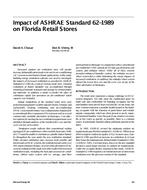Description
Increased outdoor air ventilation rates will greatly increase dehumidification loads to be met by air-conditioning (AC) systems in most humid climate applications. In this study, building energy simulation software was used to investigate the impacts of increased ventilation as specified by ASHRAE Standard 62-1989 on a typical Florida retail store. Detailed evaluation of indoor humidity was accomplished through modeling of moisture transport and storage in common building materials. In addition, a model to predict the effect of continuous supply fan operation on air-conditioner latent capacity was included.
Annual simulations of the modeled retail store were performed using hourly weather data for Miami, Orlando, and Jacksonville. Heating, ventilating, and air-conditioning (HVAC) system performance was evaluated and compared for a conventional direct expansion (DX) system as well as several commercially available alternative technologies. Cost-effective options for meeting the new ventilation requirements were identified through analysis of the installed first cost and life-cycle cost for each system.
Simulation results indicate that conventional rooftop packaged DX air conditioners with a sensible heat ratio (SHR) of 0.75 would be unable to maintain acceptable indoor humidity throughout the year under the new ventilation standard. While elevated ventilation rates increase both sensible and latent loads on HVAC systems, the ventilation load can be over 90% latent in humid climates. Several of the alternative HVAC systems evaluated in this study were able to offset the increased ventilation loads, including the heat pipe-assisted air conditioner, chilled water system with ice storage, and three pretreatment technologies in conjunction with a conventional air conditioner (100% outside air DX unit, gas-fired desiccant system, and enthalpy wheel). While all of these systems provided enhanced humidity control, the enthalpy recovery wheel system did so while minimizing the energy impacts of increased ventilation. In addition, the enthalpy wheel system offered the lowest first cost and life-cycle cost of any of the other alternative technologies.
Authors: David A. Chasar, Don B. Shirey, III
Citation: IAQ and Energy 98 Using ASHRAE Standards 62 and 90.1 Conference Papers
Keywords: October, Louisiana, 1998
Citation: IAQ Conference: IAQ 98
Product Details
- Published:
- 1998
- File Size:
- 1 file , 520 KB
- Product Code(s):
- D-8124




